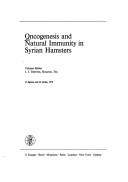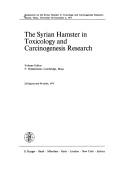| Listing 1 - 8 of 8 |
Sort by
|
Book
Year: 1968 Publisher: Ames (Iowa) : Iowa state university press,
Abstract | Keywords | Export | Availability | Bookmark
 Loading...
Loading...Choose an application
- Reference Manager
- EndNote
- RefWorks (Direct export to RefWorks)
Golden hamster. --- Brain --- Atlases.
Article
Abstract | Keywords | Export | Availability | Bookmark
 Loading...
Loading...Choose an application
- Reference Manager
- EndNote
- RefWorks (Direct export to RefWorks)
Addiction. --- Bar chewing. --- Golden hamster. --- Golden-hamster. --- Golden-hamsters. --- Hamster. --- Hamsters. --- Kept. --- Pet. --- Pets. --- Running wheel.
Article
Abstract | Keywords | Export | Availability | Bookmark
 Loading...
Loading...Choose an application
- Reference Manager
- EndNote
- RefWorks (Direct export to RefWorks)
Behaviour. --- Contact. --- Female. --- Golden hamster. --- Golden-hamster. --- Golden-hamsters. --- Hamster. --- Hamsters. --- Maternal behaviour. --- Maternal. --- Pups.

ISBN: 3805528248 Year: 1979 Publisher: Basel ; München ; Paris : Karger,
Abstract | Keywords | Export | Availability | Bookmark
 Loading...
Loading...Choose an application
- Reference Manager
- EndNote
- RefWorks (Direct export to RefWorks)
Cancer --- -Golden hamster --- -Viral carcinogenesis --- Microbial carcinogenesis --- Oncogenic viruses --- Hamster, Golden --- Hamster, Syrian --- Mesocricetus auratus --- Syrian hamster --- Mesocricetus --- Cancers --- Carcinoma --- Malignancy (Cancer) --- Malignant tumors --- Tumors --- Immunological aspects --- Diseases --- Golden hamster --- Viral carcinogenesis --- Carcinogenesis
Article
Abstract | Keywords | Export | Availability | Bookmark
 Loading...
Loading...Choose an application
- Reference Manager
- EndNote
- RefWorks (Direct export to RefWorks)
Physical aspects of the laboratory environment, such as type of cage or bedding, are often ignored by investigators but may be quite important for the animals. We examined whether golden hamsters preferred living in wire mesh floored, stainless steel cages or solid floored, plastic cages with corn-cob litter. Forty hamsters of 2 ages were housed in wire or solid floored cages for 3 weeks. Caging preference was then tested using a choice apparatus in which hamsters could move freely between the 2 cages for 6 days. Scan data were collected on cage occupation and behaviour. Results showed that most hamsters preferred the solid floored cage with litter, but prolonged experience on wire led to a wire floored cage preference in 40% of these animals. Also, wire-housed hamsters showed higher levels of hoarding and lower levels of gnawing behaviour during testing, and spent significantly different amounts of time from litter-housed hamsters performing sleeping, exploring, grooming, gnawing, eating, and hoarding behaviours while on solid floored cages with litter. This study shows that previous housing condition can affect cage preferences and behaviour and supports the assertion that husbandry practices can be better evaluated by asking laboratory animals, rather than only humans, how their living conditions are perceived
Age. --- Animal. --- Animals. --- Bedding. --- Behavior. --- Behaviour. --- Cage. --- Caging. --- Choice. --- Environment. --- Experience. --- Golden hamster. --- Golden hamsters,caging preferences,preference testing,animal husbandry. --- Golden-hamster. --- Golden-hamsters. --- Grooming. --- Hamster. --- Hamsters. --- Hoarding. --- Housing. --- Human. --- Humans. --- Husbandry. --- Laboratory animals. --- Laboratory environment. --- Laboratory-animals. --- Laboratory. --- Level. --- Mesocricetus auratus. --- Mesocricetus-auratus. --- Mice. --- Physical. --- Preference. --- Preferences. --- Time.
Article
Abstract | Keywords | Export | Availability | Bookmark
 Loading...
Loading...Choose an application
- Reference Manager
- EndNote
- RefWorks (Direct export to RefWorks)
Examining data describing the sex composition of 1074 Caesarean-delivered litters of house mice, 253 Caesarean-delivered and 265 vaginally delivered litters of Mongolian gerbils, and 854 vaginally delivered litters of golden hamsters, we determined whether segregation of sexes between uterine horns and correlations between litter size and litter sex ratio were present in each of the three rodent species studied. Although significant deviations from expected distributions of male and female fetuses were found, these deviations from chance were not the same in any two of the three species examined. Analyses also indicated that the correlation between litter size and litter sex ratio that Huck, Seger, and Lisk (1990) found in vaginally delivered infant hamsters is present in vaginally delivered infant Mongolian gerbils, but not in their Caesarean-delivered colony mates. In gerbils, and perhaps hamsters as well, the correlation between litter size and litter sex ratio appears to be a result of sex-biased perinatal mortality correlated with litter size rather than of sex-biased conception correlated with litter size
Behavior. --- Birth. --- Colonies. --- Female mongolian gerbils. --- Female. --- Fetuses. --- Gerbil. --- Gerbils. --- Golden hamster. --- Golden-hamster. --- Golden-hamsters. --- Hamster. --- Hamsters. --- Horns. --- House mice. --- Infant. --- Litter sex ratio. --- Litter size. --- Male. --- Meriones-unguiculatus. --- Mice. --- Mongolian gerbil. --- Mongolian gerbils. --- Mongolian-gerbil. --- Mortality. --- Mouse. --- Perinatal. --- Rodent. --- Sex ratio. --- Sex. --- Sexes. --- Size. --- Time. --- Uterine position.
Article
Abstract | Keywords | Export | Availability | Bookmark
 Loading...
Loading...Choose an application
- Reference Manager
- EndNote
- RefWorks (Direct export to RefWorks)
This study compared the capability for social entrainment of the circadian locomotory rhythms of solitary versus socially living nocturnal small mammals. Therefore single adult golden hamsters and Mongolian gerbils of both sexes were kept under LD 12:12 and then transferred in their cages to a dark chamber (DD), which was covered with an opaque material, but located permanently in a room with other conspecifics exposed to a light regime (LD 12:12). The animal in the chamber was able to detect acoustical and olfactorial stimuli of the conspecifics outside the chamber. Under these experimental conditions all the golden hamsters and gerbils investigated developed free-running rhythms of activity with an individual-specific spontaneous period. In golden hamsters these free-running rhythms were never entrained or masked. In 5 out of 6 gerbils the free-running of activity rhythms stopped after a few days and the rhythms were more or less pronounced entrained or masked. Unexpectedly the response was not induced via signals from the conspecifics but quite probably by the caretaking procedures in the animal room. Therefore, our results suggest that in neither investigated species did social entrainment of the circadian activity rhythms occur
Activity. --- Adult. --- Animal. --- Boxes. --- Cage. --- Circadian activity. --- Circadian rhythm. --- Circadian. --- Conspecific. --- Entrainment. --- Gerbil. --- Gerbils. --- Golden hamster. --- Golden-hamster. --- Golden-hamsters. --- Hamster. --- Hamsters. --- Kept. --- Light. --- Mammals. --- Masking. --- Mongolian gerbil. --- Mongolian gerbils. --- Mongolian-gerbil. --- Response. --- Rhythm. --- Rhythms. --- Sex. --- Sexes. --- Social entrainment. --- Social. --- Solitary. --- Stimuli. --- Time.

ISBN: 3805528906 Year: 1979 Publisher: Basel ; München ; Paris : Karger,
Abstract | Keywords | Export | Availability | Bookmark
 Loading...
Loading...Choose an application
- Reference Manager
- EndNote
- RefWorks (Direct export to RefWorks)
Carcinogens. --- Cricetinae. --- Neoplasms, Experimental --- Toxicology. --- Cancer --- -Carcinogenesis --- -Golden hamster --- -Hamsters as laboratory animals --- -Toxicology, Experimental --- -Experimental toxicology --- Laboratory animals --- Hamster, Golden --- Hamster, Syrian --- Mesocricetus auratus --- Syrian hamster --- Mesocricetus --- Oncogenesis --- Pathogenesis of cancer --- Tumorigenesis --- Pathology --- Genetic toxicology --- Cancers --- Carcinoma --- Malignancy (Cancer) --- Malignant tumors --- Tumors --- Evidence Based Toxicology --- Evidence-Based Toxicology --- Toxinology --- Based Toxicologies, Evidence --- Based Toxicology, Evidence --- Evidence Based Toxicologies --- Evidence-Based Toxicologies --- Toxicologies, Evidence Based --- Toxicologies, Evidence-Based --- Toxicology, Evidence Based --- Toxicology, Evidence-Based --- Pharmacogenetics --- Cricetus --- Hamsters --- Hamster --- Oncogens --- Tumor Initiators --- Tumor Promoters --- Initiators, Tumor --- Promoters, Tumor --- Benzidines --- Neoplasms --- etiology. --- Animal models --- -Congresses --- Congresses --- Physiology --- Pathogenesis --- -etiology. --- Carcinogenesis --- Golden hamster --- Hamsters as laboratory animals --- Toxicology, Experimental --- Carcinogens --- Cricetinae --- Toxicology --- Experimental toxicology --- Animal models&delete& --- Physiology&delete& --- etiology --- Carcinogen --- Oncogen --- Tumor Initiator --- Tumor Promoter --- Initiator, Tumor --- Promoter, Tumor
| Listing 1 - 8 of 8 |
Sort by
|

 Search
Search Feedback
Feedback About UniCat
About UniCat  Help
Help News
News